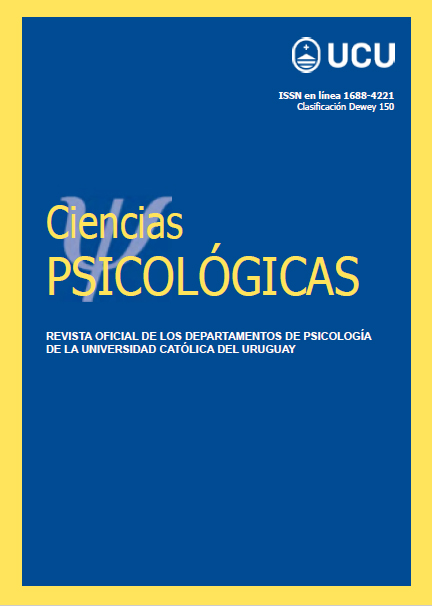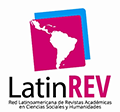Desarrollo, validación y evidencias experimentales de un diccionario de prosocialidad
DOI:
https://doi.org/10.22235/cp.v19i2.4356Palabras clave:
juego de bienes públicos, análisis lingüístico, LIWC, cooperaciónResumen
La presencia de grandes datos textuales permite el análisis automatizado de constructos psicológicos. Para ello, se han desarrollado programas que categorizan palabras e identifican, entre otros, estilos cognitivos, lingüísticos o contenido emocional. Este trabajo consta de dos estudios que presentan evidencia de validez de contenido y externa de un diccionario para estimar la prosocialidad, compatible con el software LIWC. El Estudio 1 parte de un corpus de términos construido con base en fuentes naturales y especializadas, que fue evaluado por siete jueces, lo que dio paso a la conformación de una lista definitiva. En el Estudio 2 se utilizó un juego de bienes públicos, en el que 160 participantes eligieron en un dilema económico interés propio versus bienestar colectivo. Adicionalmente, los participantes respondieron por escrito qué estrategia habían utilizado en el juego y qué emociones experimentaron. Estos textos fueron analizados con el diccionario construido en el Estudio 1. Se evidenció que la prosocialidad estimada con el diccionario se relacionó positivamente con el comportamiento cooperativo en el juego. Se encontró que el estilo cognitivo tipo II predice el comportamiento prosocial en el juego. Los dos estudios muestran la utilidad del diccionario para evaluar la prosocialidad a través del análisis lingüístico y la posibilidad de ser usado para estimar este constructo en diferentes escenarios.
Descargas
Citas
Alencar, A. I., de Oliveira Siqueira, J., & Yamamoto, M. E. (2008). Does group size matter? Cheating and cooperation in Brazilian school children. Evolution and Human Behavior, 29(1), 42-48. https://doi.org/10.1016/j.evolhumbehav.2007.09.001
Bago, B., Bonnefon, J. F., & De Neys, W. (2021). Intuition rather than deliberation determines selfish and prosocial choices. Journal of Experimental Psychology: General, 150(6), 1081-1094. https://doi.org/10.1037/xge0000968
Bailey, D. H., Winegard, B., Oxford, J., & Geary, D. C. (2012). Sex differences in in-group cooperation vary dynamically with competitive conditions and outcomes. Evolutionary Psychology, 10(1), 102-119. https://doi.org/10.1177/147470491201000112
Biber, D. (1988). Variation across speech and writing. Cambridge University Press.
Boyd, R., & Pennebaker, J. (2015). Did Shakespeare write double falsehood? Identifying individuals by creating psychological signatures with text analysis. Psychological Science, 25(5), 570-582. https://doi.org/10.1177/0956797614566658
Brandt, H., Hauert, C., & Sigmund, K. (2005). Punishing and abstaining for public goods. PNAS, 103(2), 495-497. https://doi.org/10.1073/pnas.0507229103
Burton-Chellew, M., Mouden, C., & West, S. (2016). Conditional cooperation and confusion in public-goods experiments. Proceedings of the National Academy of Sciences (PNAS), 113(5), 1291-1296. https://doi.org/10.1073/pnas.1509740113
Capraro, V., & Cococcioni, G. (2016). Rethinking spontaneous giving: Extreme time pressure and ego-depletion favor self-regarding reactions. Nature, 6. https://doi.org/10.1038/srep27219
Castiblanco, P. T. (2018). Estilo y contenido lingüístico de conversaciones en Twitter ® durante un proceso de transición a la paz [Tesis de maestría]. Universidad Católica de Colombia. https://repository.ucatolica.edu.co/bitstream/10983/19060/2/RAE.pdf
Catola, M., D’Alessandro, S., Guarnieri, P., & Pizziol, V. (2023). Multilevel public goods game: Levelling up, substitution and crowding-in effects. Journal of Economic Psychology, 97, https://doi.org/10.1016/j.joep.2023.102626
Cerdas, D., Núñez, E., & Rojas, M. (2017). Uso del modelo de Rasch para la construcción de tablas de especificaciones: Propuesta metodológica aplicada a una prueba de selección universitaria. Revista Electrónica Actualidades Investigativas en Educación, 17(1), 1-16. https://doi.org/10.15517/aie.v17i1.27299
Cone, J., & Rand, D. (2014). Time pressure increases cooperation in competitively framed social dilemmas. Plos one, 9(12). https://doi.org/10.1371/journal.pone.0115756
Conway-Smith, B., & West, R. L. (2023). Clarifying system 1 & 2 through the Common Model of Cognition. arXiv. https://doi.org/10.48550/arXiv.2305.10654
Donohue, W. A., Liang, Y., & Druckman, D. (2014). Validating LIWC Dictionaries: The Oslo I Accords. Journal of Language and Social Psychology, 33(3), 282-301. https://doi.org/10.1177/0261927X13512485
Evans, J. (2008). Dual-processing accounts of reasoning, judgment, and social cognition. Annual Review of Psychology, 59(3), 255-278. https://doi.org/10.1146/annurev.psych.59.103006.093629
Evans, J., & Stanovich, K. (2013). Dual-process theories of higher cognition: Advancing the debate. Perspectives on Psychological Science, 8(3), 223-241. https://doi.org/10.1177/1745691612460685
Fischbacher, U., & Gächter, S. (2010). Social preferences, beliefs, and the dynamics of Free riding in public goods experiments. American Economic Review, 100(1), 541-556. https://doi.org/10.1257/aer.100.1.541
Frimer, J. A., Aquino, K., Gebauer, J. E., Zhu, L., & Oakes, H. (2015). A decline in prosocial language helps explain public disapproval of the US Congress. Proceedings of the National Academy of Sciences, 112(21), 6591-6594. https://doi.org/10.1073/pnas.1500355112
Garzón-Velandia, D. C., Barreto, I., & Medina-Arboleda, I. F. (2020). Validación de un diccionario de LIWC para identificar emociones intergrupales. Revista Latinoamericana de Psicología, 52, 149-159. https://doi.org/10.14349/rlp.2020.v52.15
Goeschl, T., & Lohse, J. (2016). Cooperation in public good games. Calculated or confused? European Economic Review, 107, 185-203. https://doi.org/10.1016/j.euroecorev.2018.05.007
Grayson, S., Feinberg, M., Willer, R., & Zaki, J. (2025). Ironic effects of prosocial gossip in driving inaccurate social perceptions. Journal of Experimental Social Psychology, 116. https://doi.org/10.1016/j.jesp.2024.104682
Grehl, S., & Tutić, A. (2022). Intuition, reflection, and prosociality: Evidence from a field experiment. Plos one, 17(2). https://doi.org/10.1371/journal.pone.0262476
Hayes, S. C., & Sanford, B. T. (2014). Cooperation came first: Evolution and human cognition. Journal of the Experimental Analysis of Behavior, 101(1), 112-129. https://doi.org/10.1002/jeab.64
Hawkins, R. C. II, & Boyd, R. L. (2017). Such stuff as dreams are made on: Dream language, LIWC norms, and personality correlates. Dreaming, 27(2), 102-121. https://doi.org/10.1037/drm0000049
Hou, C., Li, S., Shi, H., & Liu, Z. (2024). The influence of social exclusion on prosocial behavior of college students: the role of relational need threat and regulatory focus. Frontiers in Psychology, 15. https://doi.org/10.3389/fpsyg.2024.1384279
Ilhan, M. (2016). A comparison of the results of many facet Rasch analyses based on crossed and judge pair designs. Educational Sciences: Theory & Practice, 16(2), 579-601. https://doi.org/10.12738/estp.2016.2.0390
Inglés, J., Martínez, A. E., Valle, A., García, J., & Ruiz, C. (2011). Conducta prosocial y motivación académica en estudiantes españoles de Educación Secundaria Obligatoria. Universitas Psicológica, 10(2), 451-466. https://doi.org/10.11144/Javeriana.upsy10-2.cpma
Kahneman, D. (2011). Thinking, fast and slow. Macmillan.
Lee, C. H., Kim, K., Seo, Y. S., & Chung, C. K. (2007). The relations between personality and language use. Journal of General Psychology, 134(4), 405-413. https://doi.org/10.3200/GENP.134.4.405-414
Li, S., Du, C., Li, X., Shen, C., & Shi, L. (2024). Antisocial peer exclusion does not eliminate the effectiveness of prosocial peer exclusion in structured populations. Journal of Theoretical Biology, 576. https://doi.org/10.1016/j.jtbi.2023.111665
LIWC INC. (2022). LIWC. https://www.liwc.app/help/howitworks
Logan, M., & Hall, M. (2019). Comparing crime types: a linguistic analysis of communiqués associated with the animal and earth liberation movement. Dynamics of Asymmetric Conflict, 12(2), 164-181. https://doi.org/10.1080/17467586.2019.1613554
Luengo Kanacri, B. P., Eisenberg, N., Tramontano, C., Zuffiano, A., Caprara, M. G., Regner, E., Zhu, L., Pastorelli, C., & Caprara, G. V. (2021). Measuring prosocial behaviors: Psychometric properties and cross-national validation of the prosociality scale in five countries. Frontiers in Psychology, 12. https://doi.org/10.3389/fpsyg.2021.693174
Marín-Escobar, J. C., Marín-Benítez, A. C., Maury-Mena, S. C., Guerrero, C. M., & Maury, A. (2024). La prosocialidad: estrategia de educación integral frente a la violencia. Revista Latinoamericana de Ciencias Sociales, Niñez y Juventud, 22(1), 120-143. https://doi.org/10.11600/rlcsnj.22.1.5681
Markowitz, D., & Hancock, J. (2017). The 27 club: Music lyrics reflect psychological distress. Communication Reports, 30(1), 1-13. https://doi.org/10.1080/08934215.2016.1210663
Martí-Vilar, M., Merino-Soto, C., & Rodriguez, L. M. (2020). Measurement invariance of the prosocial behavior scale in three Hispanic countries (Argentina, Spain, and Peru). Frontiers in Psychology, 11(29). https://doi.org/10.3389/fpsyg.2020.00029
Martínez-González, A. E., Inglés Saura, C., Piqueras Rodríguez, J. A., & Oblitas Guadalupe, L. A. (2010). Papel de la conducta prosocial y de las relaciones sociales en el bienestar psíquico y físico del adolescente. Avances en Psicología Latinoamericana, 28(1), 74-84.
Martinsson, P., Myrseth, K. O. R., & Wollbrant, C. (2014). Social dilemmas: When self-control benefits cooperation. Journal of Economic Psychology, 45, 213-236. https://doi.org/10.1016/j.joep.2014.09.004
Montero, I., & León, O. G. (2007). A guide for naming research studies in Psychology. International Journal of Clinical and Health Psychology, 7(3), 847-862. https://www.redalyc.org/pdf/337/33770318.pdf
Myrseth, K. O. R., Riener, G., & Wollbrant, C. E. (2015). Tangible temptation in the social dilemma: Cash, cooperation, and self-control. Journal of Neuroscience, Psychology, and Economics, 8(2), 61-77. https://doi.org/10.1037/npe0000035
Otten, K., Frey, U. J., Buskens, V., Przepiorka, W., & Ellemers, N. (2022). Human cooperation in changing groups in a large-scale public goods game. Nature Communications, 13(1), 6399. https://doi.org/10.1038/s41467-022-34160-5
Overduin , J. (2015). Online interventions in consumer conflicts [Tesis de maestría]. Universidad de Twente.
Pennebaker, J. W., Chung, C., Frazee, J., Lavergne, G., & Beaver, D. (2014). When small words foretell academic success: The case of college admissions essays. Plos one, 9(12). https://doi.org/10.1371/journal.pone.0115
Pennebaker, J. W., Francis, M. E., & Booth, R. J. (2001). Linguistic inquiry and word count: LIWC 2001. Lawrence Erlbaum Associates.
Pennebaker, J. W., Mehl, M. R., & Niederhoffer, K. G. (2003). Psychological aspects of natural language use: Our words, Our selves. Annual Review of Psychology, 54(1), 547-577. https://doi.org/10.1146/annurev.psych.54.101601.145041
Quiroga-Rojas, A. T., Ardila-Cubillos, D. C., Rojas, D., Monroy, C., Mendoza, A., Manrique, V., Montoya, S., & Sarmiento, L. (2020). Bases cognitivas subyacentes al altruismo en adolescentes y adultos jóvenes. En I. F. Medina-Arboleda, I. Barreto, D. R. Aguilar-Pardo, & M. C. Sandoval-Escobar (Eds.), Perspectivas y contextos de la prosocialidad (pp. 177-195). Editorial Universidad Católica de Colombia & Konrad Lorenz Editores. https://doi.org/10.14718/9789585133471.2020
Ramírez-Esparza, N., Pennebaker, J., García, A., & Suriá, R. (2007). La psicología del uso de las palabras: Un programa de computadora que analiza textos en español. Revista Mexicana de Psicología, 24(1), 85-99.
Rand, D. G., & Epstein, Z. G. (2014). Risking your life without a second thought: Intuitive decision-making and extreme altruism. PLOS One, 9(10). https://doi.org/10.1371/journal.pone.0109687
Rand, D., Greene, J., & Nowak, M. (2012). Spontaneous giving and calculated greed. Nature, 489, 427-430. https://doi.org/10.1038/nature11467
Rand, D. G., & Nowak, M. A. (2013). Human cooperation. Trends in Cognitive Sciences, 17(8), 413-425. https://doi.org/10.1016/j.tics.2013.06.003
Rostovtseva, V., Weissing, F., Mezentseva, A., & Butovskaya, A. (2020). Sex differences in cooperativeness—An experiment with Buryats in Southern Siberia. PLOS One, 15(9). https://doi.org/10.1371/journal.pone.0239129
Rude, S. S., Gortner, E.-M., & Pennebaker, J. W. (2004). Language use of depressed and depression-vulnerable college students. Cognition and Emotion, 18(8), 1121-1133. https://doi.org/10.1080/02699930441000030
Simpson, B., & Willer, R. (2015). Beyond altruism: Sociological foundations of cooperation and prosocial behavior. Annual Review of Sociology, 41(1), 43-63. https://doi.org/10.1146/annurev-soc-073014-112242
Spinrad, T. L., & Eisenberg, N. (2014). Empathy, prosocial behavior, and positive development in schools. In M. J. Furlong, R. Gilman, & E. S. Huebner (Eds.), Handbook of positive psychology in schools [2nd ed.] (pp. 82-98). Routledge/Taylor & Francis Group.
Skatova, A., & Ferguson, E. L. (2013). Individual differences in behavioral inhibition explain free riding in public good games when punishment is expected but not implemented. Behavioral and Brain Functions, 9, 3. https://doi.org/10.1186/1744-9081-9-3
Struwe, N., Blanco, E., & Walker, J. M. (2024). Increasing benefits in one-time public goods does not promote cooperation. Proceedings of the National Academy of Sciences, 121(41). https://doi.org/10.1073/pnas.2410326121
Teoh, Y. Y., & Hutcherson, C. A. (2022). The games we play: Prosocial choices under time pressure reflect context-sensitive information priorities. Psychological Science, 33(9), 1541-1556. https://doi.org/10.1177/09567976221094782
Toro, R., Barreto-Zambrano, M. L., Garzón-Velandia, D. C., Sandoval-Escobar, M., Pineda-Marín, C., O’Sullivan, C., Taylor, L., Kerezsy-Morales, G. K., Giraldo-Puerto, M. A., Cárdenas-Ruiz, S., Ramírez-Sierra, Y. V., Alfonso, D., Duarte, J. V., & Niño Amézquita, J. L. (2023). Empatía, agresividad y perdón en contextos de vulnerabilidad, hostilidad y seguridad en niños y adolescentes. Revista Latinoamericana de Psicología, 55, 18-28. https://doi.org/10.14349/rlp.2023.v55.3
Unesco. (2010). Compendio de los Manuales del SERCE. https://unesdoc.unesco.org/ark:/48223/pf0000191940
van Hoorn, J., Van Dijk, E., Meuwese, R., Rieffe, C., & Crone, E. A. (2014). Peer influence on prosocial behavior in adolescence. Journal of Research on Adolescence, 26(1), 90-100. https://doi.org/10.1111/jora.12173
Veloso, C., Muñoz, N., Palza, A. L., Roa, C., Tapia, C., & Lee, S. L. (2015). Asociación de inteligencia emocional, satisfacción vital con conducta prosocial en jóvenes escolarizados de la XV región. LÍMITE Revista Interdisciplinaria de Filosofía y Psicología, 10(34). https://revistalimite.uta.cl/index.php/limite/article/view/49
Zasiekin, S., Kuperman, V., Hlova, I., & Zasiekina, L. (2022). War stories in social media: Personal experience of Russia-Ukraine war. East European Journal of Psycholinguistics, 9(2), 160-170. https://doi.org/10.29038/eejpl.2022.9.2.zas
Descargas
Publicado
Cómo citar
Número
Sección
Licencia
Derechos de autor 2025 Ciencias Psicológicas

Esta obra está bajo una licencia internacional Creative Commons Atribución 4.0.
















